Whether you have no reputation or a damaged one, it’s already affecting trust, clicks, and sales—whether you notice it or not. The upside? You don’t have to sit still and let it get worse. You can start fixing it today with a clear plan and a few high-leverage actions you can repeat every month.
Below is a practical roadmap for improving your online reputation—what to do now, what to build next, and how to keep momentum going while avoiding tactics that violate review platform policies.
Work with a Reputation Management Expert
The fastest path to results is partnering with someone who manages reputations every day. There are dozens of reputation management firms to choose from, including specialists for local businesses, personal brands, and B2B companies.
A great partner will help you: develop a compliant review acquisition program that follows each platform’s policies, clean up inaccurate listings, publish positive assets that rank, and create response playbooks for major scenarios. From personal brands and local shops to multi-location companies, the right firm tailors strategy to your goals and risk tolerance—so you don’t have to hire in-house or learn it all from scratch.
Create (Or Optimize) Your Website
Treat your website as your online home base—the one asset you fully control. Social platforms are useful, but you’re always subject to their algorithms and policies. Your site is where your brand story, proof, policies, and contact paths live.
Website builders make it easy to launch quickly with solid performance and security defaults. If you already have a site, audit Core Web Vitals (page speed, responsiveness, visual stability) and fix issues that hurt trust and conversions.
Start with a lean structure (Home, About, Services/Products, Reviews/Testimonials, Contact). Expand with FAQs, detailed service pages, and resource content over time. This isn’t just for companies—individuals can also benefit from a simple portfolio or personal site that highlights accomplishments, press, speaking, and ways to get in touch.
For credibility, add real photos, a clear value proposition above the fold, fast load times, HTTPS, and easy ways to reach you (phone, email, chat). Include an on-site reviews/testimonials page and use appropriate structured data where eligible (for example, Product or Service reviews that aren’t self-serving). Note that testimonials about your own business on your own site typically aren’t eligible for review rich results; treat them primarily as social proof for users.
Expand Your Presence
Where can people verify who you are and what you do? Your reputation improves when accurate, consistent information appears everywhere someone looks.
Don’t rely on a single review platform. Different customers research in different places and across devices.
Having a Facebook page is a good start.
But it’s not enough on its own. Review sites people check vary by industry and location, and no single platform dominates every situation.
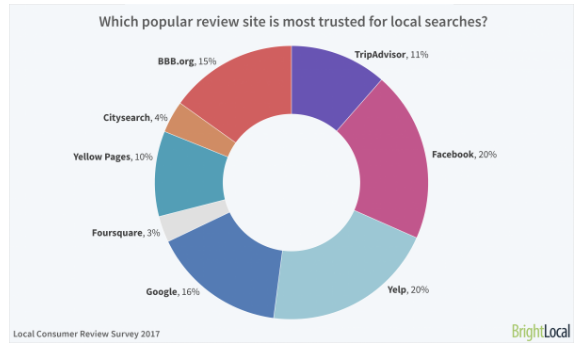
Even if specific rankings shift over time, the takeaway stands: your customers discover and evaluate you across multiple platforms.
- Yelp
- Google (Google Business Profile)
- Tripadvisor
- Better Business Bureau
- Yellow Pages
- Apple Maps (via Apple Business Connect)
- Bing Places
- Trustpilot, G2, or Capterra (for software and B2B)
- Glassdoor and Indeed (for employer reputation)
Create or claim your profile on each relevant site—then fully complete it with photos, categories, descriptions, and the same name, address, and phone (NAP) you use on your website.
Also claim any unowned listings you find. Customers can leave reviews on many sites even if you’ve never set up an account. Claiming lets you correct details, add photos, and respond to feedback.
Verify essentials: website URL, phone, address, hours, service area, and holiday hours. Inaccurate info can compound a bad impression. Keep everything consistent across platforms—consistency is a trust signal to both people and search engines.
If someone sees a negative review but still gives you a shot, the last thing you want is a dead phone line or wrong hours. Control the basics so you don’t lose that second chance.
Finally, consider Apple Business Connect and Bing Places as well—many users rely on Apple Maps and Bing search results, especially on mobile and Windows devices. Apple now lets businesses manage place cards, photos, promotions, and Insights directly in Apple Maps through Apple Business Connect.
Ask Your Customers to Write Reviews
Negative reviews happen. They shouldn’t define you—unless they’re the only reviews visible.
Balance comes from volume. If you have many happy customers, you need a simple, repeatable way to invite them to share their experience without violating platform policies.
Identify your happiest customers (post-purchase, after support resolutions, or following successful engagements) and ask for feedback while the experience is fresh.
A polite, clear request works best. Provide direct links to the platforms that matter most to your business, and make the process mobile-friendly. Avoid “review gating” (only asking satisfied customers) and don’t offer incentives on platforms that prohibit them (Google and Trustpilot prohibit incentives). Yelp specifically discourages asking for reviews at all; focus there on great service and profile completeness rather than direct asks.
Check out this email Sleefs sent to its customers:
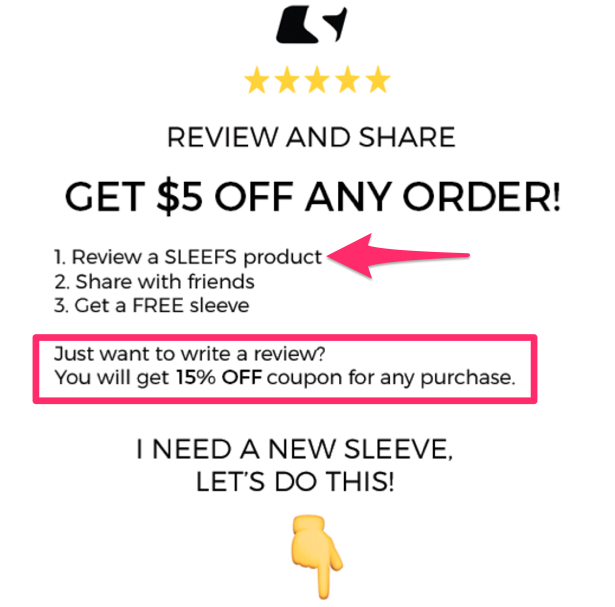
The company offers an incentive to encourage participation, without dictating a positive rating. That said, always check each platform’s review policies—many prohibit incentives for reviews or “review gating.” On Google and Trustpilot, incentives are not allowed; on Yelp, don’t ask for reviews at all. Keep asks neutral and compliant, and when in doubt, skip incentives and simply make leaving a review as easy as possible.
Offer channel choice (Google, site testimonial form, industry-specific platforms) so people can use what they prefer. Short instructions and a one-click review link dramatically improve completion rates.
If customers want to share with friends, that social proof is a bonus. If they simply leave a review, that added volume helps dilute the impact of a few negative experiences.
Emojis and friendly language can lift click-throughs in emails and texts. Keep the tone human and appreciative—never pushy.
A healthy mix of positive, neutral, and occasional negative reviews looks authentic. Perfection can look fake; transparency builds credibility.
Bottom line: make it easy, ethical, and consistent to ask for reviews. Over time, your ratings and search visibility will reflect the true quality of your business.
Showcase Customer Testimonials
Third-party reviews are powerful. You can amplify them by featuring standout quotes and stories on your website.
Invite your happiest customers to share a testimonial. Ask for specifics (problem, solution, result) and permission to use their name, title, company, and photo. The more concrete the details, the more believable the praise.
Here’s an example of how BuildFire uses testimonials prominently on its homepage:
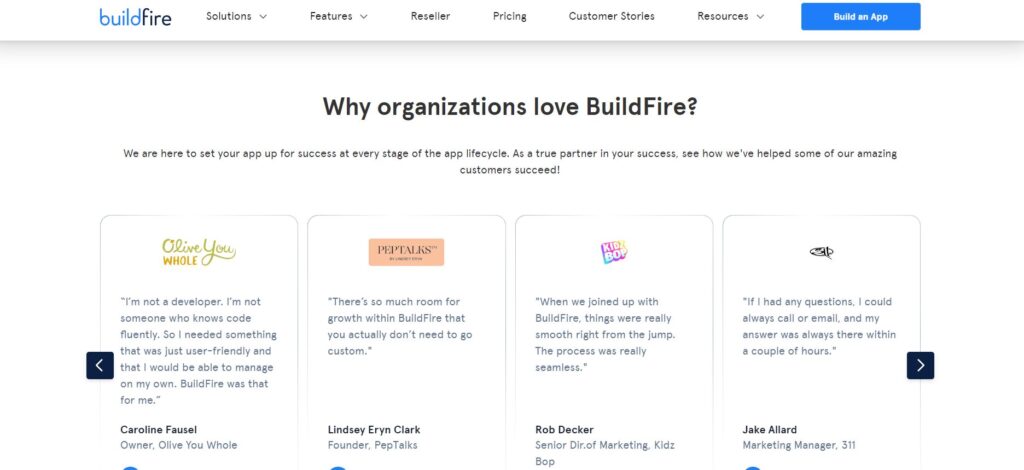
Notably, the testimonials come from different industries and recognizable brands—excellent for credibility and relevance across audiences.
When possible, prioritize testimonials from authoritative customers (well-known organizations, respected professionals, or verified experts). Their names carry weight and can nudge hesitant buyers.
For example, if you sell musical instruments, a quote from a touring guitarist or a music educator will likely resonate more than a generic review.
Publicly Respond to Customer Complaints
Unfavorable reviews put you in a tough spot. You want to defend your team, but arguing online rarely plays well. People are watching to see how you handle friction.
First, assume good intent and acknowledge the experience. Share empathy, apologize if appropriate, and outline the next step toward resolution.
Don’t ignore complaints—silence suggests indifference. Timely, thoughtful replies show you care and often turn critics into advocates.
Remember the classic rule: the customer is always right—or at least deserves to be heard with respect.
Even if the review is unfair, focus on fixing the issue rather than winning the argument. Keep it short, kind, and action-oriented.
Here’s how Best Buy responded to a customer complaint on Facebook:
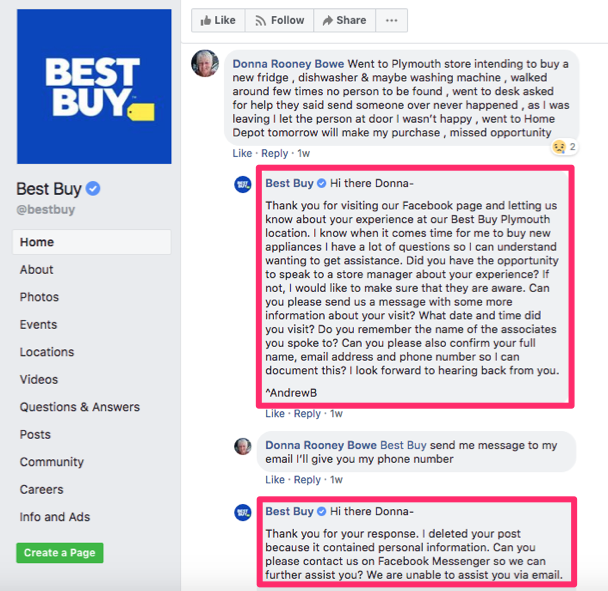
The customer reported a problem at a specific store. Best Buy acknowledged the issue, asked for details, and moved toward a resolution—no defensiveness, just service.
When follow-up was needed, Best Buy responded again while protecting privacy. That’s the model: acknowledge, guide next steps, avoid sharing personal info publicly, and keep the tone calm.
Pro tip: prepare response templates for common scenarios (shipping delays, billing issues, service quality) so your team can respond quickly and consistently. Add a clear escalation path and empower frontline responders to resolve simple issues without multiple handoffs.
Remove Ads From Your Website
Your site design can quietly undermine trust. Busy pages, intrusive popups, and irrelevant ads make you look less credible—and they slow pages down.
Fixes include cleaner layouts, readable typography, clear headings, and fast, mobile-friendly pages. Make it obvious how to contact you, and display policies (returns, warranties, privacy) without friction.
Identify the top elements adding credibility to your website, then compare them to your own.
One of the first changes to consider—if it won’t materially hurt revenue—is removing third-party display ads. Irrelevant or overly aggressive ads can erode trust and distract from your primary offer.
Yes, ad revenue can help. But weigh it against the lifetime value of a new customer and the credibility cost of clutter. If your core business is selling products or services, prioritize that experience over third-party ads.
Also avoid intrusive interstitials and heavy scripts that can hurt user experience on mobile. Clean pages and quick load times build confidence. If you must use popups, cap frequency, delay the trigger, and ensure they’re easy to dismiss.
Encourage Customers to Upload Their Photos
Reviews with real-world photos are compelling. They feel authentic and help shoppers set expectations.
Many buyers trust customer photos more than polished brand shots. Encourage uploads where your customers naturally post reviews.
It makes sense: your photos are staged to look great; customer photos show what buyers actually experienced.
Authenticity beats perfection. Smartphone photos are enough to help someone click “buy”—especially when attached to a thoughtful review.
Here’s how JCPenney has encouraged customer photo uploads with an email campaign:
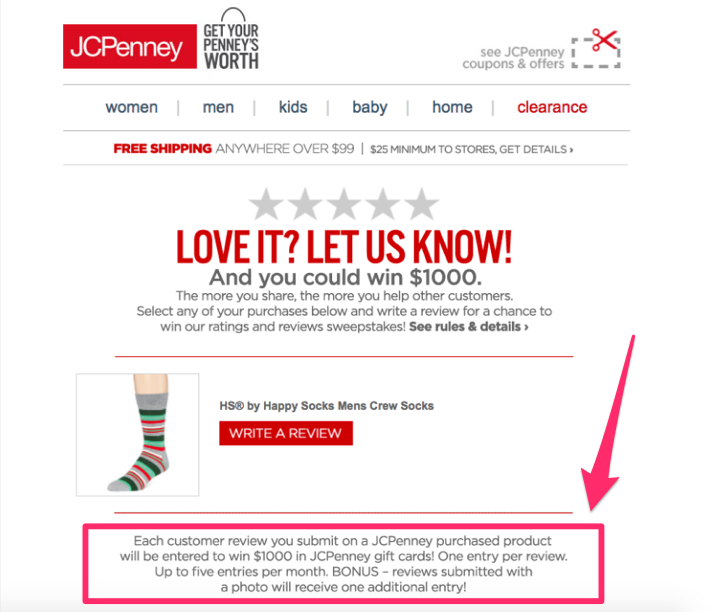
In this example, reviews enter customers into a prize draw, with an extra entry for including a photo. As always, check the review site’s rules—some platforms prohibit incentives. If allowed, keep the language neutral and don’t request a positive rating. When incentives aren’t allowed, simply provide clear “how to upload a photo” steps to reduce friction. (On Trustpilot, incentives aren’t allowed; on Yelp, don’t ask for reviews at all.)
This type of campaign can work well as part of a broader giveaway strategy.
Ask customers to upload photos along with their reviews, and consider simple prompts (“Show how you’re using it” or “Before/after”). Clear prompts produce better submissions.
Share User-Generated Content
Customer photos attached to reviews are great—but you can amplify them by featuring user-generated content (UGC) on your social channels.
Not every reviewer will add a photo. Curate the best customer posts and reshare with permission, credit, and thanks.
UGC lets you highlight authentic, relatable images that align with your brand and seasonality.
Check out this Instagram example from Vuori Clothing:

Real customers wearing the product beat studio shots for social proof. Tag creators, ask permission to repost, and thank them publicly.
UGC builds trust because shoppers see people like them succeeding with your product. That credibility translates into higher engagement and conversions.
For best results, define a brand hashtag, repost consistently, and collect rights to reuse UGC in email and on your website. Keep a lightweight approval process so you can publish quickly while staying on-brand.
Take Advantage of Tools That Monitor Your Reputation
How healthy is your online reputation right now?
If you haven’t had a major crisis, you may not have a clear picture. A few scattered reviews and comments don’t tell the whole story.
Use monitoring tools to catch mentions across the web—social, news, forums, blogs, and review sites—so you can respond quickly and spot patterns early.
Set up Google Alerts for your brand name, executive names, product names, and common misspellings.
You can also try specialized platforms like Rankur or other reputation tools that aggregate reviews and track sentiment for online reputation management—use whichever provides the coverage and reporting you need. If you manage Apple Maps listings, Apple Business Connect provides built-in Insights (searches, views, and actions) you can review monthly.
We recommend testing a few options. Configure alerts for spikes in negative mentions, track review volume and average rating by platform, and schedule weekly summaries so nothing slips through. If you operate multiple locations, consolidate reporting so you can spot outliers quickly.
You can’t improve what you don’t measure. Visibility is step one; action is step two.
Start Prioritizing Your Blog
Publishing helpful, trustworthy content improves domain authority and reputation. It also gives people (and search engines) more reasons to believe you’re the real deal.
Blogging is one of the most reliable ways to demonstrate expertise, earn links, and rank for the questions your customers ask.
If you’ve followed us for a while, you know we’re bullish on content. Blog posts can also drive qualified leads, not just traffic.
Post on a consistent schedule. Cover your core topics deeply with how-tos, comparisons, case studies, and FAQs. Link internally to your products/services and cornerstone guides, and include clear next steps.
Use images, charts, and infographics to make concepts easier to grasp and more shareable. When other sites reference your work, you earn authority and visibility.
Add author bios, cite reputable sources, disclose conflicts where relevant, and update older posts regularly—these signals help readers and search engines trust your content.
Partner With Social Influencers
Influencers extend your reach and create the peer-to-peer trust that’s hard to manufacture with ads alone.
Independent research consistently shows that recommendations from peers and creators influence purchase decisions, especially in visually driven categories.
That’s the appeal: credibility at scale—when it’s a fit.
Here’s how CALIA partnered with Anastasia Ashley on Instagram:

Posting on the influencer’s account puts your brand in front of a highly engaged audience that already trusts the messenger.
Look for genuine alignment (audience, values, content style). Micro-influencers often deliver strong engagement at lower cost. Always disclose sponsorships and get usage rights for repurposing content. On Meta platforms, avoid fake or misleading user reviews or engagement.
A few well-matched creators can outperform a broad, unfocused campaign. Quality beats quantity. Track performance with unique links or codes so you can double down on what works.
Tried Everything and Still No Luck? It’s Time to Outsource
Reputation management is ongoing work—monitoring, responding, publishing, and improving never really stop.
If you’re stretched thin, bring in help. Your time is valuable, and the opportunity cost of DIY can exceed the fee. A good partner will execute ethically, report clearly, and free you to focus on growth.
